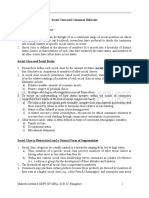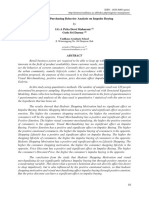0% found this document useful (0 votes)
69 views13 pagesImpact of Social Class On Consumer Behaviour: Presented By: Abhishek Gomber Narender Jakhar
The document discusses the impact of social class on consumer behavior. It outlines 9 categories of social class and methods for measuring social class, including subjective self-perception, objective demographic variables like occupation and income. Consumer preferences and behaviors vary across social classes - upper classes prefer theaters, concerts and football while lower classes favor television and cricket. Upper classes are more future-oriented investors while lower classes prioritize immediate gratification. Communication habits also differ, with higher classes favoring newspapers and current events over quiz shows and sitcoms preferred by lower classes.
Uploaded by
Narender Jakhar AdvCopyright
© Attribution Non-Commercial (BY-NC)
We take content rights seriously. If you suspect this is your content, claim it here.
Available Formats
Download as PPT, PDF, TXT or read online on Scribd
0% found this document useful (0 votes)
69 views13 pagesImpact of Social Class On Consumer Behaviour: Presented By: Abhishek Gomber Narender Jakhar
The document discusses the impact of social class on consumer behavior. It outlines 9 categories of social class and methods for measuring social class, including subjective self-perception, objective demographic variables like occupation and income. Consumer preferences and behaviors vary across social classes - upper classes prefer theaters, concerts and football while lower classes favor television and cricket. Upper classes are more future-oriented investors while lower classes prioritize immediate gratification. Communication habits also differ, with higher classes favoring newspapers and current events over quiz shows and sitcoms preferred by lower classes.
Uploaded by
Narender Jakhar AdvCopyright
© Attribution Non-Commercial (BY-NC)
We take content rights seriously. If you suspect this is your content, claim it here.
Available Formats
Download as PPT, PDF, TXT or read online on Scribd
/ 13























































































